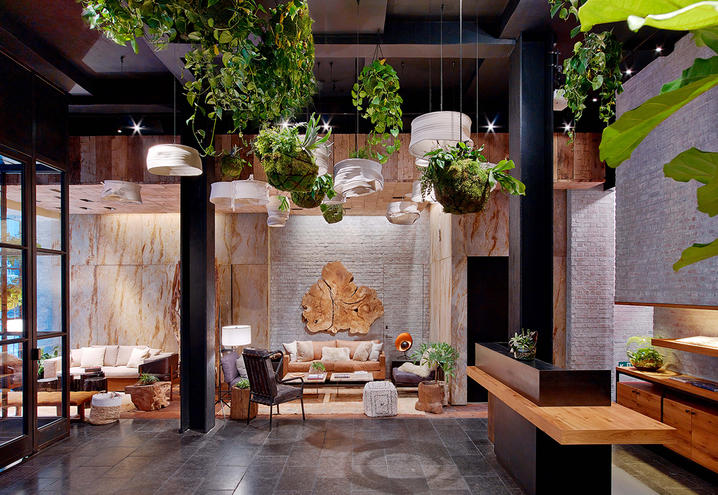When we hear the term ‘wellness’, we generally think of it referring to lifestyle and relaxing spa therapies. But the truth is, that this term includes designing wellness within the four walls of our homes, offices and of course our spas.
We spend 56% of our lives at work, and 90% of our lives indoors. And with indoor air quality being five times more polluted than outdoor air, we can quickly begin to see why ‘sick building syndrome’, was officially recognized by the World Health Organization in 1986. Diseases that could be linked to the home or spa, include allergies, fatigue, asthma, hay fever and recurrent colds and flus.
The current challenge within the spa industry is that so many spas lack proper ventilation or even windows, and coupled with walking in with shoes, shedding layers of skin and emotion within the treatment room, its possible that our spas could be far more physically and energetically toxic than most homes and offices.
So how do we design wellness spaces?
In hunter-gatherer days, indigenous people assessed the life and prosperity of land by observing plants and animals, so as to avoid ‘sickness country’. In modern times, a detailed ‘building biology’ checklist can be used when choosing the best site for your wellness space, even if it’s in an urban environment.
Setting a clear intention for how your spa will serve as a wellness destination, will then inform the design process, whereby a number of elements can be considered, from geopathic stress to feng shui principles to air purity and ventilation, use of natural light, electrical wiring, green walls and heating and cooling choices.
The next step in wellness design also considers the health of the planet, by using sustainably sourced and/or recycled materials in the initial construction of a spa. These ethical choices also impact on our wellbeing, as new buildings ‘off gas’ high levels of VOCs (Volatile Organic Compounds) from treated woods, insulation, gyprock, paints, glues and sealants. Building materials may also contain radioactive nuclides, particularly cement, bricks and stone.
Wellness design then extends into the selection of finishes and fixtures, which include floors, carpets, upholstery padding, furniture, fabrics and built in cabinetry, all of which, also ‘off gas’ high levels of VOCs. Therefore being the major cause of poor indoor air quality.
If building a new spa is just not on the financial agenda right now, then there’s still many ways that wellness can be implemented within an existing spa. And the points spoken of below, also apply to the final elements crucial to a new spa design.
Air Purity & Ventilation – Many spas are designed without windows, and hence air ventilation is absent. There are a number of air purifiers on the market. However the humble household plant is the most effective air purifier, because plants balance humidity levels, pull contaminants out of the air, reduce airborne moulds and bacteria, and absorb carbon dioxide and release oxygen.
Dust – The primary source of dust is human skin cells along with walking inside with shoes. Consider a guest journey that has clients and staff leave their shoes at the door. Avoid fabric curtains and too many fabric furnishings. Use a slightly damp microfiber cloth to clean surfaces and floors. Choose cushions and bedding made from natural fibers and wash regularly in hot water and then air dry in the sun. And use a vacuum cleaner with a hepa filter and motorized head.
Mould – Is extremely toxic and must be removed at all costs, as this will be affecting the health of you and your team. You might even have to relocate your business due to the serious health consequences. In the meantime, clean with vinegar.
Water Filters – These are not a luxury, but rather an absolute necessity. Ensure you are drinking pure water and equally serving pure water to guests.
Electro Magnetic Frequencies - Exist wherever there is electricity and can negatively impact on our health and the ability to relax. There are a number of considerations when choosing a site and then when building, but in terms of an existing spa, its important to remove cordless phones and wifi as well as turn off all power points when appliances are not in use.
Cleaning Chemicals – Affect the health of our space, as well as the planet. In leading the way of wellness, its imperative that spas use natural cleaning products, eucalyptus oil and essential oils as air fresheners. If possible, source an eco-laundry service for the laundering of towels, which come into direct contact with the skin.
Cooling & Heating – Air conditioners need to be maintained so as to not become a health hazard and not all heating is created equal and needs to be considered.
Candles – While there is nothing nicer than the gentle flicker of a candle, the truth is that most candles (unless they are made from beeswax or soy) are actually filling your space with carcinogenic chemicals, which can cause cancer and affect the central nervous system. Buy good quality candles or use rechargeable candles.
Showers & Chlorine – When showering in warm water, our guests are exposed to high levels of chlorine. Consider a Vitamin C showerhead filter, which reduces chlorine by 99% and offers your spa a USWP (unique wellness selling point).
Incense – There is nothing more spiritually evocative than the smell of incense, however it does cause air pollution and it is recommended to stop using incense.
Smudging Ceremony - Natives believe the spirits of sacred plants such as sage, are called to drive away negative energy and restore the balance to a particular space. And quite surprisingly a study in the Journal Ethnopharmacology found that the process of ‘smudging’ a space for one hour caused a 94 percent reduction in the bacterial count of the room. And the energetic clearing will increase the vibration.
In summary, as the spa industry leads the way in wellness, it’s important that we begin to consider taking a ‘whole’ approach to wellness and truly caring for our clients, our selves and our teams, through the way we design our spaces.


